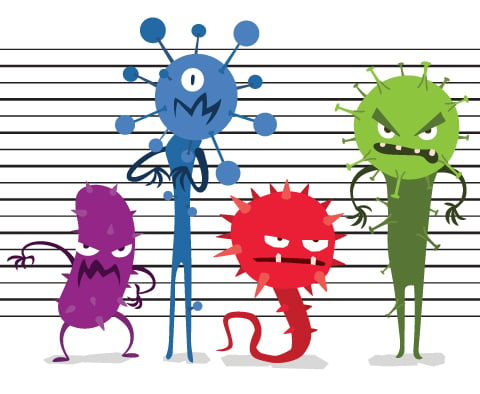Sexually Transmitted Diseases (STDs)
STDs, also called sexually transmitted infections (STIs), are infections that are passed from one person to another through sexual contact. The contact is usually vaginal, oral, or anal sex. But sometimes they can spread through other intimate physical contact, such as skin-to-skin.
STDs can be caused by bacteria, viruses and parasites.
Some of the most common STDs include the following:
CT (Chlamydia Trachomatis): In women, CT can infect the cervix, rectum, or throat. In men, the urethra, rectum, or throat can be infected.
Gonorrhea: Can infect women and men, in the same areas as CT.
HPV (Human Papilloma Virus): Causes warts, mainly in the genital or rectal areas of both men and women.
HSV (Herpes Simplex Virus): Causes recurring outbreaks of small, painful, fluid-filled blisters on the genitals in both women and men.
MG (Mycoplasma Genitalium): In women, the vagina, womb (uterus) and fallopian tubes, and urethra may become infected; in men, MG infects the urethra and epididymis (tube that carries sperm).
Trich (Trichomoniasis): In women, trich usually infects the lower genital tract (vulva, vagina, cervix, urethra). In men, the urethra is commonly infected.
In addition, two common conditions that are usually caused by an STD are Bacterial Vaginosis (BV) and Pelvic Inflammatory Disease (PID).
STD Symptoms
STD symptoms vary, depending on the infection, and many times, there are no symptoms at all, which is why it’s important to be tested. Some symptoms common to many STDs include:
- Painful or frequent urination
- Pain, itching or a discharge from the vagina or penis
- Pain or discomfort during or after sex
- A rash or small red bumps or blisters
If you or your partner has symptoms of an STD, or if your partner has been diagnosed with an STD, it is important to be tested, even if you don’t have symptoms.
MicroGenDX Tests Used in Diagnosing STDs
An STD test may be done in the clinic and sent off to a lab, or you can do an at-home test. An evaluation and culture (growing microbes from your sample in a lab) are often used to diagnose an STD. However, standard cultures may come back negative even when you actually do have this infection, and that means it won’t be treated, and some STDs are difficult to culture.
In contrast to a standard culture, a MicroGenDX test detects the DNA of all microbes in your sample, along with how much of each is present, and uses that information to identify the bacteria in your infection and the drugs that can best treat it. It is important to know that not all antibiotics work for all bacteria, and some even work differently in different areas of the body. Your doctor should consult the "antimicrobials for consideration" chart on your MicroGenDX report to decide what antibiotic is right for you.
The type of MicroGenDX test you will order depends on the type of infection you are likely to have:
Chlamydia: “Basic STI Panel” at https://microgendx.com/product/basic-sti-panel-dm-intl/ or
“Full STI Panel” at https://microgendx.com/product/full-sti-panel-dm-intl/
Gonorrhea: “Basic STI Panel” at https://microgendx.com/product/basic-sti-panel-dm-intl/ or
“Full STI Panel” at https://microgendx.com/product/full-sti-panel-dm-intl/
HPV: “HPV Test Service” at https://microgendx.com/product/hpv-panel-dm-intl/
HSV: “HSV Test Service” at https://microgendx.com/product/hpv-panel-dm-intl/
MG: “Full STI Panel” at https://microgendx.com/product/full-sti-panel-dm-intl/
Trich: “Full STI Panel” at https://microgendx.com/product/full-sti-panel-dm-intl/
BV: “Vaginal Test Service” at https://microgendx.com/product/vaginal-test-service/
PID: “Vaginal Test Service” at https://microgendx.com/product/vaginal-test-service/ or
“WomensKEY Complete Urine + Vaginal Test” at https://microgendx.com/product/womens-complete-urine-vaginal-swabs-dm-intl/
Providing a Sample for an STD Test
For most STDs, you will provide a urine sample or a swab sample, sometimes both. It’s very important to obtain a proper sample by following the instructions for collecting the sample, as well as when packaging and shipping it.
Everything you need to know about taking a sample is included with your test, and is also available online on the product pages for each test. The instructions contain illustrations that will help you collect a sample without contaminating it. For example, you will need to wash your hands thoroughly and clean your genital area with soap and water, and pay special attention to the gender-specific instructions so that bacteria on the skin aren’t included in your sample.
Medical Specialties Treating STDs
An STD can be treated by a primary care physician or infectious disease specialist. Depending on the infection, it can also be treated by a urologist or an OB/GYN.
How STDs are Treated
If an STD is caused by a bacterial infection, it will be treated by one or more antibiotics. If the STD is caused by a fungus (“yeast” infection), it may be treated with antibiotics or an antifungal topical cream or ointment. If it is caused by a virus, one or more different types of drugs may be tried. It is important to complete the full course of medication when it is prescribed, even if symptoms begin to clear up before you are finished.
Some strains of the bacterium that causes a particular STD can develop resistance to specific antibiotics, so that they cannot be effectively treated with those antibiotics. This is why all MicroGenDX diagnostic tests include detection of antibiotic resistance genes in your sample, and then provide alternative antibiotics for your doctor to consider prescribing to you.

